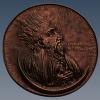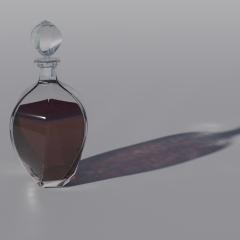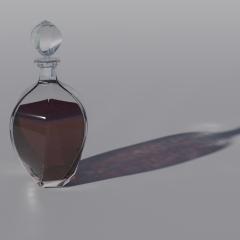-
Posts
2,189 -
Joined
-
Last visited
Content Type
Forums
Calendar
Gallery
Everything posted by L'Ancien Regime
-
What are you running that Octane on? the RTX 2080Ti? I would have gone that route except they were all dying when they first came out so I got the Radeon VII.
-
-
So it only seemed logical to wind up the gilt glass bottle with its own caustic light render. I did it in 4K and it's got some nasty artifacts. It's a pretty rough and ready example but the caustics turned out pretty nice. Once I get a Cintique in a few months I'll completely redo it properly. One word of advice to all of you who want to try your own caustics; you can set up all the lights you need and everything looks great and then you plug in the photon target glass or liquid and son of a gun it all goes incandescent on you like a magnesium fire, especially the fluid. The answer isn't to play with your direct light settings or ambient light settings. And it isn't your photon count. It's the energy level of your refractive light. And that's not the refractive index of the light take note. It's the refractive light. If your liquid or the base of your glass container is blindingly incandescent then look into your glass or translucent liquid material and crank down your Refraction Energy or Refraction Intensity or whatever to one fifth or even one twentieth of the stock setting.
-
Octane is a good choice. Fast and has great IOR material library. I take it, it's like Maxwell on steroids. It would be good if you did a review of it here sometimes.
-
And I'm finding that in objects like this, it's not even worth your while to retopo them (AUTOPO or manually) and then extract maps. Just switch them over from voxel to surface mode, do an automatic poly reduction on export and render them as is. After all your render engine is going to take whatever you throw at it, be it NURBS, BREP or SubD polygons with maps and it's going to just winnow them down to mini triangle polys in their hundreds of thousands anyway, so why even bother with all the extra procedures if you're not working with something that requires a lot of maps? This just takes 15 minutes to create, set up, and render. And it's always a good idea to shrink your liquid object a tiny bit so there won't be any artifacts from an intersection between the transparent container and it's liquid contacts that will produce unpleasant artifacts in the render. eg. tumbler's scale; .01 whiskey object scale; .0098
-
I know the perfect render engine for you to use, ultimately; Isotropix Clarisse. Rocket fast and capable of immense detail on a huge, infinite scale just like in your compositions. I talked to the guy who created it twice. An Iranian who grew up in France, a big guy, super intelligent mathematician/programmer and very friendly. All that runs on CPU. He did a personal demo for me at Siggraph in Vancouver. All that runs just as fast as you see in the videos on just a laptop, a Lenovo ThinkPad, with a ***** GPU. It's all CPU. You can do massive hyper complex intensely detailed landscapes almost to infinity in almost real time. The only thing it didn't have back three or four years ago was caustics and hyper real glass. But it might have improved on that account since then.
-
Am I ever happy; just getting caustics in my glass renders ended up being a lot easier than I expected though I'm sure with work and experimentation I can get better caustics examples than this. But I'll take this for now and be happy with it. I've always loved computer graphics renders of fine glass work, like high end magazine ads for perfume bottles, and now the way is open to have a hell of a lot of fun in the immediate future. And you know, adding caustics and making the carafe, it's stopper and the wine photon targets seems to have done something to it all. The glass has an extra smoothness to it, the wine has a more real quality to it. I suspect adding more photons to the mix will give a purer caustic casting of red light onto the ground than it has now with its blotches of white in there.
-
The bottle really needed to be twisted more. The wine is sort of meh at this point.[
-
Glass poses so many problems. I'm going to have to figure out caustics...
-
That's what I like to see; think big, think on a grandiose scale.
-
I'm in love. And she's in Montreal. She's the most accomplished of all the ones you've posted so far.
-
Actually I went back to my installation of Pro Render and it had completely erased itself from my computer, nowhere to be found! Then I went to AMD to download it and reinstall it and they wanted me to form an account. They refused outright to recognize my Protonmail account. I suppose they want an ISP based mail account which is ridiculous. It's a free program. Why the security?
-
I mean, just look at this; this is just one little detail from an immense section on rendering in Houdini with Mantra and how it's connected with lights, and cameras and materials, ROPS (Render Operators) and SOPS (surface operators) and on and on. (The Diffuse Limit is just one obscure parameter among dozens perhaps a hundred, maybe thousands of parametric adjustments In this example, increasing the Diffuse Limit has a dramatic effect on the appearance of the final image. To replicate realistic lighting conditions, it is often necessary to increase the Diffuse Limit. However, since the amount of light contribution usually decreases with each diffuse bounce, increasing the Diffuse Limit beyond 4 does little to improve the visual fidelity of a scene. Additionally, increasing the Diffuse Limit can dramatically increase noise levels and render times. https://www.sidefx.com/docs/houdini/render/limits_tab.html It's beautiful. That's a beautiful little render. And it edifies you. It's almost like it's the Holy Bible of VFX and CGI. This is how I'd like to see the manual for 3D Coat.
-
You know what would make the best basis for a meticulous manual, in the manner of Houdini? The programmer's notes buried right in the code. // We need to multiply quantity by 2 here because they are bought in pairs cost = quantity * 2 * storePrice; All the code is annotated to avoid confusion as it's passed up and down the pipeline of labor . It should be a commentary that goes into the greatest detail not only what each tool is doing but what each parameter inserted is for and how it's linked to other operations and dynamic databases within the program. That's the kind of molecular level of information that the manual we need should be drawn from. It's not 3D Coat v2 anymore. It's a serious vital tool now, not a casual toy. That's probably an insane thing to propose but it felt good to say it.
-
That's amazing destruction work
-
I find the documentation is deplorable in 3D Coat and that's very frustrating because it's my favorite go to tool. The manual is totally superficial to the point of being useless. Videos are scattered and often insufficient (or just completely antiquated) for serious work, leaving vast aspects of a tool's functionality unmentioned. Everything should be thoroughly documented and put up for us the way it is in say, Houdini. I'm trying to learn the new Polyhedron tool and unless Digman comes back to politely and patiently explain it to me then I'm at a loss. And digman doesn't work for 3d Coat and so it's unfair that he should be the only teacher around here to tell us how to use this program in depth. And man, does digman ever know this program in depth. Ditto for Vertex Painting. There's one or two very superficial videos on this workflow. When you design these tools why not write down what you're thinking and how they're supposed to be used in a workflow in great detail? Then just put it up as part of your documentation for us to study.
-
nice
-
So I reworked the bottle stopper and in doing so I discovered that a Normal Map is essential to rendering glass. By reworking it's displacement entirely with the normal map in ppp, it just popped, crystalline clear, the way it was supposed to be, not murky or sandblasted as it initially appeared. To do that with the rest of the bottle I'll have to redo the gold pattern on it using a normal map instead of just a painted displacement identical to the painted gold alpha basically. Even with just a mouse it should be much better second time round. I didn't have time for that tonight but I did have time to apply a simple normal map to the .obj slab of amber liquid in the crystal flask. That and removing some base color blue that was tucked away in the liquid shader's base color made it look a lot more like some kind of perfume and not yesterday's coffee in your secretary's styrofoam cup.
-
Is this 3D Coat or is this Zbrush?






